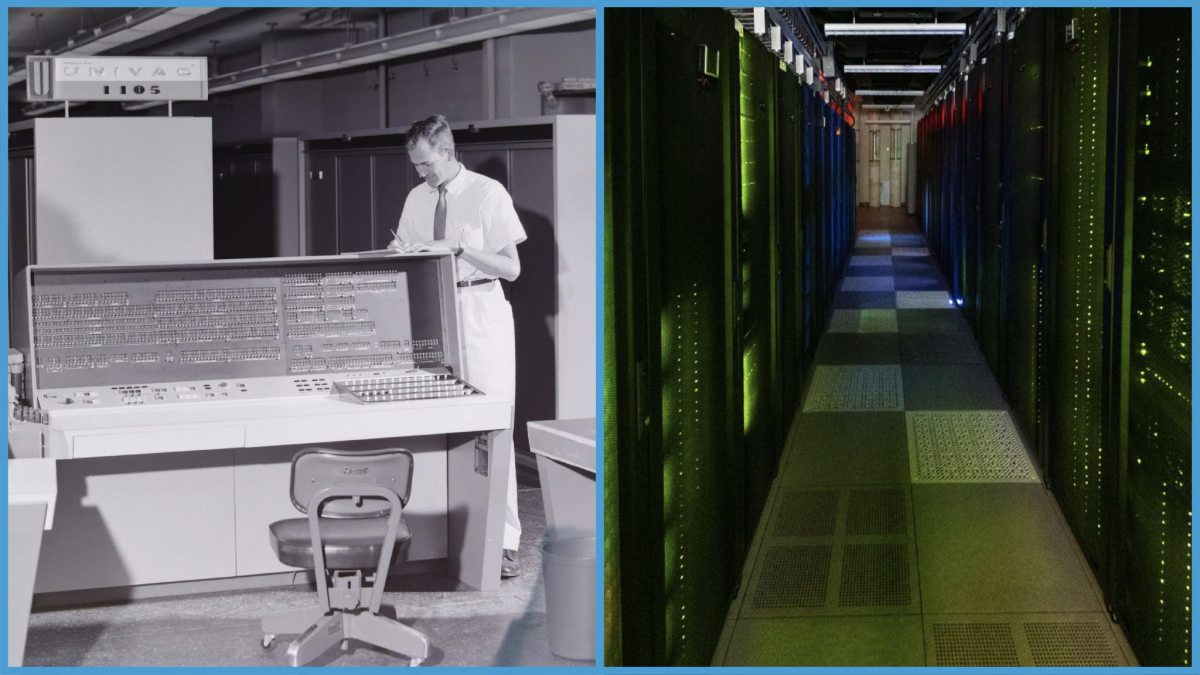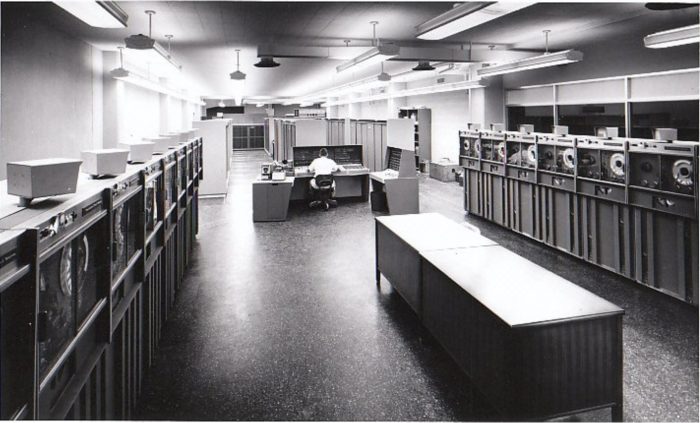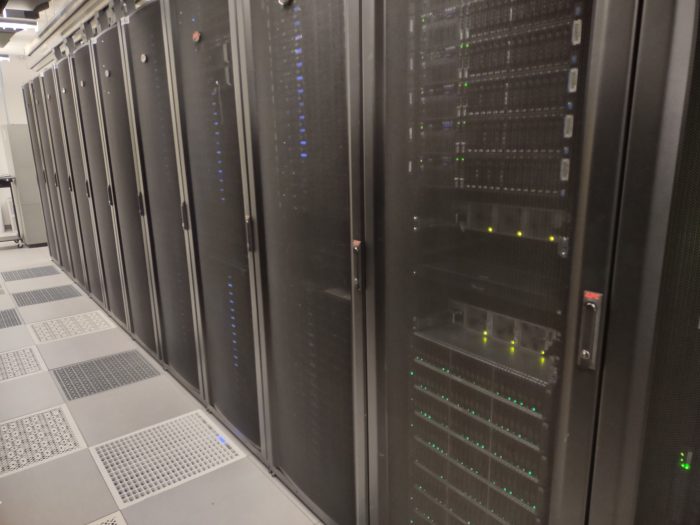7 decades of difference: Carolina’s 1st computer and its current cluster
A computing pioneer, Carolina installed the UNIVAC 1105 to process data for the 1960 U.S. Census. Today, its primary computing cluster, the Longleaf, supports thousands of research endeavors.

Contemporary computing looks wildly different from 1959, when Carolina acquired its first computer, Sperry Rand’s UNIVAC 1105.
Computing today is ubiquitous. Since 2000, Carolina has required all undergraduate students to have a laptop computer. Campus-wide Wi-Fi provides 24/7 internet access. Faculty, staff and students rely on computers for research, teaching, learning and their work supporting the University in its mission.
Despite that ubiquity, we can still draw parallels — and note stark contrasts — between that first “supercomputer” and Carolina’s primary research computing cluster, Longleaf.
The UNIVAC 1105 arrived on campus with a huge responsibility as one of four computers in the United States to process data for the 1960 census. Rather than servicing one monumental task at a time, Longleaf enables simultaneous research endeavors across all disciplines including the humanities.
Pioneering computing at Carolina aimed to “enlarge the boundaries of human knowledge in all areas of concern to its faculties and students,” according to a pamphlet published for the dedication of the Computation Center, which housed the UNIVAC 1105. Today, Longleaf helps carry out this mission, servicing nearly 200 University departments and institutions.
Sperry Rand UNIVAC 1105
The site of many firsts, the nation’s first public research university was home to one of the first digital processors used by the U.S. Census Bureau. Housed in the basement of Phillips Hall, the UNIVAC 1105 was one of the most advanced computers in existence at the time of its installation in 1959. Despite the computer’s original purpose of processing census data, the University championed the machine’s potential for departmental versatility.
- Cost: $2.4 million ($24 million in today’s money)
- Weight: 19 tons
- Memory: 36-54 kilobytes
- Storage: 5 megabytes of tape storage
- Configuration:
- Monolithic, meaning it was a single computer that could only be interacted with directly by system administrators.
- The computer could only service one single-threaded, non-interruptible job at a time.
- Usership: Because of its limited capacity, after performing 1960 census tasks, the computer was primarily used by University departments and units such as UNC Finance and UNC Human Resources.

Before the installation of the UNIVAC 1105, the floors of Phillips Hall had to be reinforced with steel beams. (University Archives)
“Wherever quantitative thinking, speaking, writing, or action is involved, services of computing devices are required. The depth and scope of these quantitative activities are determined, in a large measure, by the versatility, speed, and other attributes of the computing facilities used.”
— William M. Whyburn, vice president for graduate studies and research of the consolidated university, 1957
Longleaf cluster
Carolina’s primary research computing cluster, Longleaf, is not the fastest, most powerful system. But, its heterogeneous structure allows the cluster to change and advance with shifting computing demand, says John McGee, assistant vice chancellor for ITS Research Computing. Longleaf is accessible to anyone with an ONYEN through a fair-share system that sets up a queue for computing demand. For larger projects, however, researchers are encouraged to purchase part of the cluster for their specific need.
Longleaf’s accessibility model is something that really differentiates the computing cluster from its 1959 predecessor while at the same time achieving the earliest vision for computing at Carolina — to build knowledge in every academic realm.
- Cost: $4 million
- Weight: 2 tons
- Memory: 140 terabytes — over 2.5 billion times more RAM memory than the UNIVAC 1105
- Storage: 8 petabytes of hard drives — 1.6 billion times the storage of the UNIVAC 1105
- Configuration:
- Heterogeneous cluster model, meaning that the computer is composed of 300 different nodes — individual computing structures — that can service different projects.
- Altogether the nodes provide around 23,000 central processing units, some of which can double their actual output through hyperthreading. Combined, the nodes hold 140 terabytes of RAM storage.
- Usership: From February 2021 to January 2022, about 2,000 different users submitted around 30,000,000 jobs to Longleaf. That amounts to nearly 120 million hours (more than 13,689 years!) of computing time.

In this photo of the Longleaf cluster, each of the hundreds of green lights is a tiny hard drive for storage. Each of the vertically arranged blue lights represents a single node/server.
“William Whyburn’s statement still rings true today for those of us in Research Computing. We are seeing a significant rise in demand for computing and data resources from an increasing range of disciplines — it’s not just for census data or weather modeling these days. Longleaf may not be the most powerful cluster among our peers, but with its versatile, multi-purpose structure, we are able serve highly diverse needs from almost any researcher across disciplines on campus and around the world. The impact of Longleaf and the ITS Research Computing team are evidenced by the amazing depth and scope of the world-class research community that we serve here at UNC.”
— John McGee, assistant vice chancellor for ITS Research Computing, 2022




